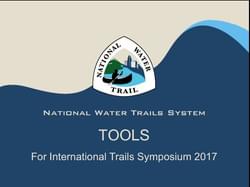Why Water Trails?
Local Economic Benefits, Statewide Networks, and National Tools
How to connect economics with tourism.
by
Sarah Hippensteel Hall, PhD, Manager, Watershed Partnerships, Miami Conservancy District,
Lelia Mellen, National Park Service,
Douglas Leed, Recreational Planner, Ohio Department of Natural Resources
This session discusses ways to connect economics with tourism to increase support for rivers and water trails. It features a toolbox of water trail research compiled and created by the National Park Service and their supporting partners to assist with water trail and access development, landowner concerns, signage plans, and other resources to use during the public planning process.
View This Presentation Online

About the Authors
Sarah believes that water is a critical element for community health and prosperity and communities who enjoy their rivers are more likely to protect their water. She currently serves as the Manager of Watershed Partnerships for the Miami Conservancy District, a 101-year old watershed agency. She builds diverse partnerships across many boundaries to protect and restore healthy rivers and aquifers, and improve and promote river access and recreation.
She graduated from Antioch University in 2010 with a PhD in Leadership and Change. She also teaches undergraduate courses in leadership studies, and resource scarcity and conflict. In 2012 she was presented with a Distinguished Service Award by the Water Management Association of Ohio. In 2015 she was selected to give a TedX Talk entitled “Water. It’s time to make it personal.”
Contact: [email protected]
Lelia Mellen works for the National Park Service Rivers & Trails Program as the National Water Trail Leader and the Director of New Hampshire Projects. This is a position she has held for over 20 years and as such she works with national water-oriented groups, community groups, local and state agencies, and nonprofits to help them with their conservation initiatives. These groups ask for assistance on river recreation and protection, open space protection and trail work.
Lelia has helped with organizational development, fundraising, river and water trail management, trail building, event planning, and open space protection. In essence, she grasps the conservation needs and desires of the group and tries to help them meet their goals. Lelia received her Master of Environmental Management from Duke University and her Bachelor of Arts in Geography from Dartmouth College.
Contact: [email protected]
Douglas Leed has administrated the Ohio Water Trails Program, maintained and updated the Ohio Motorized Boating Facilities and Stream Access databases, and served as Recreational Planner for the Division of Watercraft since 2007. He has worked for ODNR since 2001, previously working with the Division of Mineral Resources Management in the Engineering Section designing Abandoned Mine Land reclamation projects.
Douglas obtained a Bachelors degree from Miami University where he majored in Architecture and minored in Landscape Architecture.
In his spare time, Douglas enjoys outdoor activities like hiking, biking, and kayaking as well as playing guitar, audio engineering and recording, and watching movies.
Contact: [email protected]
More articles by these authors
More articles in this category
2022 CDT Small Business Survey
posted Feb 14, 2023
From August to December 2021, the Continental Divide Trail Coalition surveyed 136 small business owners in 38 communities located along the Continental Divide Trail to learn more about how the Continental Divide Trail impacts their businesses, the local economy, and their support for public lands.
Impact of Trails Hub
posted Apr 11, 2022
Everything you need to know about the positive impact of trails on health, environment, economics, and more.
Five Iconic Trails Under 50 Miles
posted Feb 15, 2021
A trail need not be over 100 miles in length to become a travel destination. Plenty of people desire shorter trail experiences and are willing to design a trip around them just the same.
1,113 views • posted 02/19/2018





